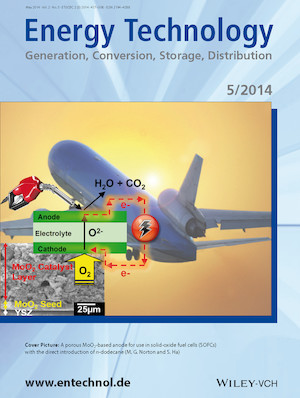 Cover Picture: High-Performance Molybdenum Dioxide-Based Anode for Dodecane-Fueled Solid-Oxide Fuel Cells (SOFCs) (Energy Technol. 5/2014)
Cover Picture: High-Performance Molybdenum Dioxide-Based Anode for Dodecane-Fueled Solid-Oxide Fuel Cells (SOFCs) (Energy Technol. 5/2014)
It works with liquid fuels: A MoO2-based anode with an interconnecting network of pores has been shown to exhibit both excellent ion- and electron-transfer properties for operation in a solid-oxide fuel cell (SOFC) with the direct feed of an n-dodecane fuel mixture (i.e., a jet-A fuel surrogate). As described in the Communication on page 425 by M. Grant Norton and Su Ha of Washington State University along with colleagues at Kyung Hee University and Boeing Commercial Airplanes, this novel fuel cell generated an initial maximum power density 3 W cm−2 at 750 °C and maintained this high initial activity over 24 h with no coking. The addition of 500 ppm of sulfur into the fuel stream did not deactivate the cell. The ability of the MoO2-based SOFC to operate with the direct input of complex liquid fuels makes it a promising energy converter to meet the increasing electrical power demand of future airplane designs.




